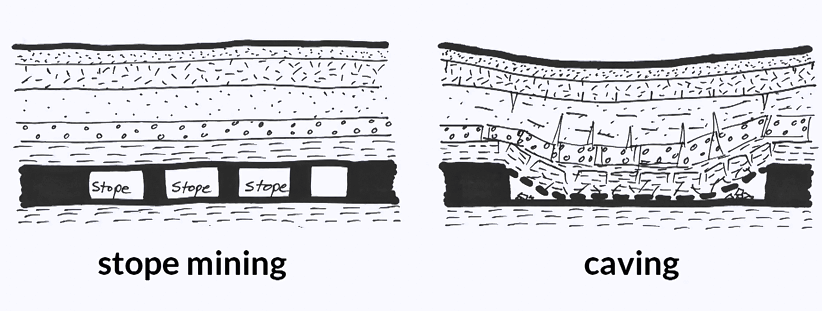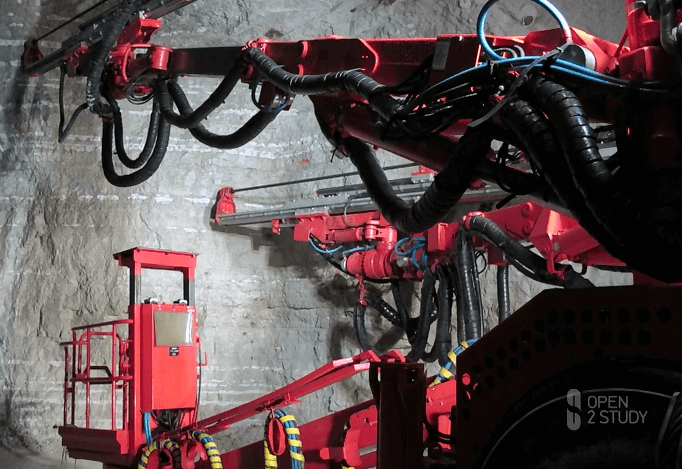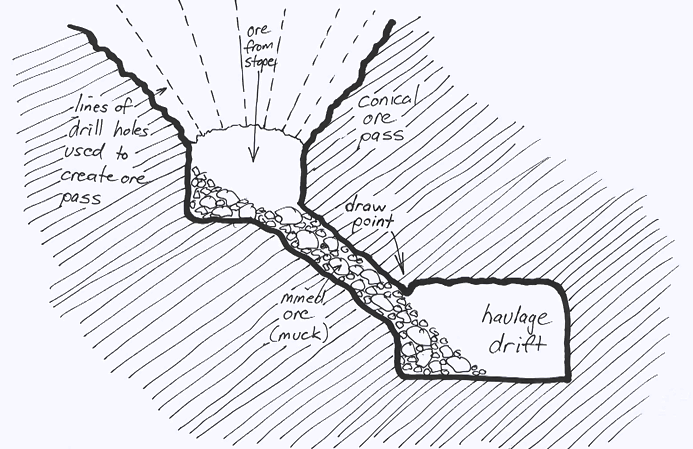The choice of an underground mining method depends on a range of factors and these include; the size and shape of the deposit, the orientation or slope of the deposit, the depth of the deposit, geological structures, characteristics of the ore and the surrounding rocks and issues with gas and water. In combination, these factors allow us to determine an appropriate arrangement and sequence for mining operation but before going on to look to see how they combine to mine specific geological ore bodies, let’s have a look and familiarize ourselves at the different basic elements of an underground mine and there basic purpose. 
Before an underground deposit can be mined it must be accessed. Access to an underground ore body is achieved through a combination of shafts which are vertical tunnels, drifts and drives which are horizontal tunnels and declines and ramps which are inclined tunnels. Access provides for getting people and equipment to the ore body, getting mined ore and waste out of the mine, ventilation and emergency egress and getting waste and tailings in to backfill the mine.In general the access arrangement for people, equipment, ore and air are separated. Typically declines are good for movement of equipment and people while shafts are efficient for the movement of ore.  This figure shows a 3d module of the mine for the vertical ore body embodying the basic elements. As was alluded to in topic one, one of the disadvantages of underground mining is the need to manage the overlying rock as the ore is extracted. Any portion of the ore body that’s left behind for operational reasons during mining is lost to production because excess structures are mostly permanent it makes sense to like locate those outside the ore body in the worthless rock beside. This is also good for safety reasons in the event that they might happen to be an unexpected collapse in the ore body during mining. The excavation of access structures is generally undertaking in what is referred to as development phase and it is described as dead work.
This figure shows a 3d module of the mine for the vertical ore body embodying the basic elements. As was alluded to in topic one, one of the disadvantages of underground mining is the need to manage the overlying rock as the ore is extracted. Any portion of the ore body that’s left behind for operational reasons during mining is lost to production because excess structures are mostly permanent it makes sense to like locate those outside the ore body in the worthless rock beside. This is also good for safety reasons in the event that they might happen to be an unexpected collapse in the ore body during mining. The excavation of access structures is generally undertaking in what is referred to as development phase and it is described as dead work. Once the ore body has been accessed it is removed block by block by under-stoping or by caving. The stope is the open space left behind when ore is removed impliciting the idea of stope mining is the idea that the roof does not collapse after a stope has been created. This is in contrast to caving where it is intended that the stope is temporarily only and that the roof of the excavation will systematically collapse as part of the mining operation. In order to keep a stope open something must hold up the roof when the ore is removed. There are two basic ways of achieving this. Open stoping is where pillars of ore between the stopes are left behind. Supported stoping is where it artificial supports are installed between the stopes to support the roof allowing the pillars between the stopes to be removed. We will look at these approaches in greater details in the next topic.
Once the ore body has been accessed it is removed block by block by under-stoping or by caving. The stope is the open space left behind when ore is removed impliciting the idea of stope mining is the idea that the roof does not collapse after a stope has been created. This is in contrast to caving where it is intended that the stope is temporarily only and that the roof of the excavation will systematically collapse as part of the mining operation. In order to keep a stope open something must hold up the roof when the ore is removed. There are two basic ways of achieving this. Open stoping is where pillars of ore between the stopes are left behind. Supported stoping is where it artificial supports are installed between the stopes to support the roof allowing the pillars between the stopes to be removed. We will look at these approaches in greater details in the next topic.  Stopping and caving can be carried out using a range of different mining operations. These include; digging, cutting, hammering and blasting. The choice of a particular excavation method depends upon the strength of the ore and the geological conditions. Digging is carried out using buckets or excavated type machines. Cutting is carried out using machines called road hitters or continuous miners which consist of rotating cutting heads mounted on a mechanically controlled arms and fitted with tongues and cowboy tipped peaks. Hammering is carried out using a hydrolic or pneumatically controlled peak on the end of a mechanically controlled arm. Blasting involves the use of explosives installed in drilled holes to split or possible fire rock from an intek rock mass. The picture shows a hole being drilled in rock. These processes result in a pile of broken or under-mined floor referred to as mack. The process of removing that from the mine is referred to as macking or macking. Macking is sometimes carried out by the equipment used to create the mack. In other cases mac is cleaned from the floor using machinery such as shovel loaders, LHD or Load Dump Auto Loaders and arm loaders. The ore is then transported to a loading point using auto loaders or shuttle carts. If the ore is too coarse to be moved it may be crushed underground first to make it transportable. Mine door underground can be taken to the surface by rail mountain wagons, self powered by a rope up an inclined ramp, trucks and shuttle carts holding up an inclined ramp conveyors installed into inclined ramps or by skips hold up shafts by winches.
Stopping and caving can be carried out using a range of different mining operations. These include; digging, cutting, hammering and blasting. The choice of a particular excavation method depends upon the strength of the ore and the geological conditions. Digging is carried out using buckets or excavated type machines. Cutting is carried out using machines called road hitters or continuous miners which consist of rotating cutting heads mounted on a mechanically controlled arms and fitted with tongues and cowboy tipped peaks. Hammering is carried out using a hydrolic or pneumatically controlled peak on the end of a mechanically controlled arm. Blasting involves the use of explosives installed in drilled holes to split or possible fire rock from an intek rock mass. The picture shows a hole being drilled in rock. These processes result in a pile of broken or under-mined floor referred to as mack. The process of removing that from the mine is referred to as macking or macking. Macking is sometimes carried out by the equipment used to create the mack. In other cases mac is cleaned from the floor using machinery such as shovel loaders, LHD or Load Dump Auto Loaders and arm loaders. The ore is then transported to a loading point using auto loaders or shuttle carts. If the ore is too coarse to be moved it may be crushed underground first to make it transportable. Mine door underground can be taken to the surface by rail mountain wagons, self powered by a rope up an inclined ramp, trucks and shuttle carts holding up an inclined ramp conveyors installed into inclined ramps or by skips hold up shafts by winches. Skips conveyors and rails systems are semi-permanent infrastructure and so they are not easily relocated. However, the location of mining activity changes with time. This means that ore from the mac needs to be transported underground to places where it can be loaded and carried to the surface. As we noted earlier, this can be done using shuttle carts and LHD loaders. However, if the design of the mine is really clever it’s possible to locate loading points deep at the lowest levels of the mine and to deliver ore to those through shoots using gravity. This is done using vertical or inclined shoots called ore-passers, specifically constructed for that purpose. Ore passers can have conical or bell shapes and may be created in the ore body itself by drilling and blasting conical radiating upward flaring ring of holes effectively creating a funnel structure. We will see examples of how these features are incorporated into efficient mining operations in the topics that follow.
Skips conveyors and rails systems are semi-permanent infrastructure and so they are not easily relocated. However, the location of mining activity changes with time. This means that ore from the mac needs to be transported underground to places where it can be loaded and carried to the surface. As we noted earlier, this can be done using shuttle carts and LHD loaders. However, if the design of the mine is really clever it’s possible to locate loading points deep at the lowest levels of the mine and to deliver ore to those through shoots using gravity. This is done using vertical or inclined shoots called ore-passers, specifically constructed for that purpose. Ore passers can have conical or bell shapes and may be created in the ore body itself by drilling and blasting conical radiating upward flaring ring of holes effectively creating a funnel structure. We will see examples of how these features are incorporated into efficient mining operations in the topics that follow.
https://youtu.be/r4hmocNQZqw
